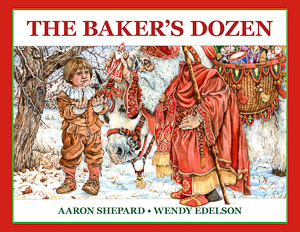Here is additional background info for my picture book.—Aaron
It is interesting to see how a legend grows and changes over time. For instance, in the legend of “The Baker’s Dozen,” the idea of a dream about Saint Nicholas has only recently been introduced, by storyteller Sheila Dailey. (Sheila’s version is on her wonderful audio tape Stories of the Long Christmas, 1986. I used the idea of the dream with her permission, but also expanded on it.)
Below is the earliest and most authoritative version of the legend I was able to find before publishing my picture book. It appears in Myths and Legends of Our Own Land, by Charles M. Skinner, Lippincott, Philadelphia and London, 1896; reprinted by Singing Tree Press, Detroit, 1969.
Since then, I’ve learned that a much earlier and much longer version appeared as “The Origin of the Baker’s Dozen,” in The Book of Saint Nicholas, by James Kirke Paulding, Harper and Brothers, New York, 1836; reprinted in part as Stories of Saint Nicholas, Syracuse University Press, Syracuse, New York, 1995. Paulding, like his contemporary Washington Irving, was a popular writer who drew from the folklore of New York state.
Skinner’s version, the one given here, is mostly drawn from Paulding’s—but there are important differences, so I suspect an additional source. I hope to yet come across it. Perhaps the most surprising element of both these versions is their humor—an element notably lacking from later retellings.
* * *
Baas [Boss] Volckert Jan Pietersen Van Amsterdam kept a bake-shop in Albany, and lives in history as the man who invented New Year cakes and made gingerbread babies in the likeness of his own fat offspring. Good churchman though he was, the bane of his life was a fear of being bewitched, and perhaps it was to keep out evil spirits, who might make one last effort to gain the mastery over him, ere he turned the customary leaf with the incoming year, that he had primed himself with an extra glass of spirits on the last night of 1654. His sales had been brisk, and as he sat in his little shop, meditating comfortably on the gains he would make when his harmless rivals—the knikkerbakkers (bakers of marbles)—sent for their usual supply of olie-koeks and mince-pies on the morrow, he was startled by a sharp rap, and an ugly old woman entered. “Give me a dozen New Year’s cookies!” she cried, in a shrill voice.
“Vell, den, you needn’ sbeak so loud. I aind teaf, den.”
“A dozen!” she screamed. “Give me a dozen. Here are only twelve.”
“Vell, den, dwalf is a dozen.”
“One more! I want a dozen.”
“Vell, den, if you vant anodder, go to de duyvil and ged it.”
Did the hag take him at his word? She left the shop, and from that time it seemed as if poor Volckert was bewitched, indeed, for his cakes were stolen; his bread was so light that it went up the chimney, when it was not so heavy that it fell through the oven; invisible hands plucked bricks from that same oven and pelted him until he was blue; his wife became deaf, his children went unkempt, and his trade went elsewhere. Thrice the old woman reappeared, and each time was sent anew to the devil; but at last, in despair, the baker called on Saint Nicolaus to come and advise him. His call was answered with startling quickness, for, almost while he was making it, the venerable patron of Dutch feasts stood before him. The good soul advised the trembling man to be more generous in his dealings with his fellows, and after a lecture on charity he vanished, when, lo! the old woman was there in his place.
She repeated her demand for one more cake, and Volckert Jan Pietersen, etc., gave it, whereupon she exclaimed, “The spell is broken, and from this time a dozen is thirteen!” Taking from the counter a gingerbread effigy of Saint Nicolaus, she made the astonished Dutchman lay his hand upon it and swear to give more liberal measure in the future. So, until thirteen new States arose from the ruins of the colonies—when the shrewd Yankees restored the original measure—thirteen made a baker’s dozen.
